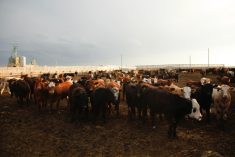MarketsFarm — Canada’s chickpea crop has likely beaten earlier expectations — but poor prices may limit farmer sales come harvest.
“We planted the crop in drought conditions” and were preparing for the worst, said Colin Young of Midwest Grain at Moose Jaw, Sask., pointing to the lack of subsoil moisture in key chickpea-growing regions of southern Saskatchewan.
However, much-needed rain early in the growing season changed the outlook.
“The rains came in the bottom of the ninth. The yields aren’t spectacular, but they’re solidly average,” Young said.
Read Also

Alberta crop conditions improve: report
Varied precipitation and warm temperatures were generally beneficial for crop development across Alberta during the week ended July 8, according to the latest provincial crop report released July 11.
Some of the most advanced chickpea crops were desiccated and ready to harvest, he said, but recent moisture across Saskatchewan will cause delays.
“The majority of chickpeas are still a month away from harvest,” he said. While that may be later than in the past two years, a September harvest is normal for the crop.
Following the 311,000 tonnes of chickpeas in 2018-19, Agriculture and Agri-Food Canada is currently forecasting a 260,000-tonne crop in 2019-20 as seeded area was down slightly. Statistics Canada’s first survey-based production estimate will be released Wednesday.
Overall, the moisture that helped save yields in early July also resulted in disease problems for about a third of the crop, according to Young. Those fields recovered somewhat, but will see reductions in yield and quality.
Another third of the acres was decent, but not spectacular, while the remaining third was quite good. Rains in the last week of August will lead to decent seed calibre, but may also cause some new quality issues.
While many farmers will have a larger chickpea crop to market than they may have anticipated during the dry spring, world markets are also well supplied, which is keeping a lid on prices.
Turkey is just wrapping up a good harvest, and has been an aggressive seller into the global market, said Young.
“Until these aggressive countries have sold their stocks, our choice is to compete at very low levels or hold and wait for our turn,” said Young. He expected the market would remain under pressure until Christmas.
Canada No. 2 or better kabuli chickpeas are currently priced in the 21-22 cents/lb. area, well below the 30 cents farmers would rather see, said Young.
Chickpeas can store well, which means actual farmer deliveries will depend on the economics for each individual farm, with ebbs and flows in the market expected over the next few months.
— Phil Franz-Warkentin writes for MarketsFarm, a Glacier FarmMedia division specializing in grain and commodity market analysis and reporting.
















